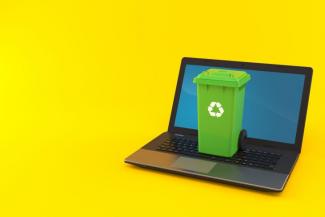
In line with growing rates of technological adoption taking place in nearly every country on the planet, the accumulation of e-waste is expected to accelerate. In 2009 it was estimated that three-quarters of end-of-life electronics were stored in people’s homes and in warehouses. The remainder was discarded as trash, becoming e-waste, which was landfilled, incinerated, reused or recycled.
The practice of landfilling or incinerating was by far the most common means of dealing with e-waste, and this trash was especially hazardous to the local environment and nearby communities. When landfilled, toxic elements in the electronics could leach into the land and contaminate groundwater, impacting the ecosystem, directly and indirectly harming human health. With an increasing volume of e-waste being generated daily, it is worthwhile to take a closer look at the regulations that govern end-of-life management services for e-waste and the businesses that play a role in curbing e-waste pollution.
E-waste became the most regulated product class under the Extended Producer Responsibility (EPR) policy mechanism as it gained considerable interest in European Union (EU) member states throughout the 2000s. The EPR required producers to manage their product’s end-of-life segment by recycling a certain tonnage of electronic waste relative to their product tonnage imported into Australia.
DHL Envirosolutions Australia was one of the approved providers of business-to-business logistics services for collecting and recycling waste on behalf of producers. The service used a cost-plus billing model that charged liable parties for DHL’s expenses on top of a viable margin, all of which was completely transparent.
DHL was successful in delivering this service, which they thought of as reverse logistics. According to Nichole Green, the Account Manager for Product Stewardship Services at DHL Supply Chain’s Envirosolutions: “We’re creating value for DHL and our stakeholders – in the first year, our nine-person team brought in a notable portion of DHL Australia’s annual revenue.”
Things changed in 2013 when in response to requests by the Australia New Zealand Recycling Platform (ANZRP), a competing provider, the Australian regulator decided not to separate the categories of Computers and Televisions and to set combined recycling tonnage requirements. This regulatory change in Australia’s product stewardship space meant that DHL could no longer silo the collection and recycle targets between the two product types, though the regulations still allowed for discriminatory pricing between the product classes of importers. This decreased the costs for television importers while increasing the costs for computer importers.
Concerned, Ms Green, the in-house expert on the regulation, brought the matter up with the Senior Director of Envirosolutions, Peter Bruce and the Operations and Compliance Manager, Mark Philips. The team will be proceeding to analyse the regulatory and competitive environment to fine-tune the company’s future strategy and to be ready for expanding opportunities in extended producer responsibility. DHL will also be proceeding to examine the underlying factors attributable to the company’s success and evaluated the feasibility of replicating its product stewardship services in other Asian markets.
Penned by Lieven Demeester, Associate Professor of Operations Management (Practice), SMU Lee Kong Chian School of Business and Christopher Dula from The Centre for Management Practice (CMP) at SMU, this case examines extended producer responsibility and reverse logistics, and discusses the competitive strategy of a B2B service provider.
To read the case in full, please visit the CMP website by clicking here.